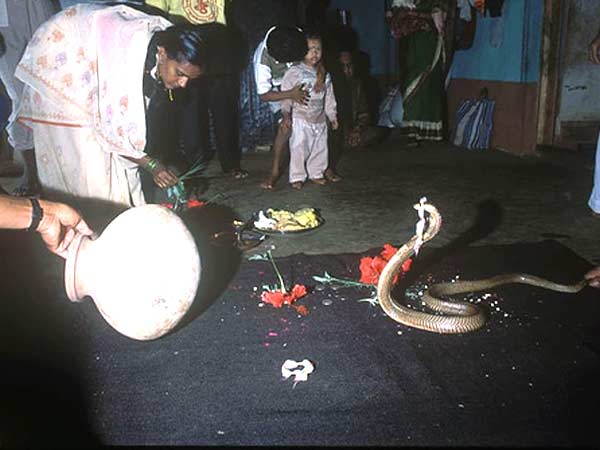A number of rituals are observed on the Hindu festival of Naga Panchami. Learn all about the traditions and customs of Nag Panchami, in the article.
Naga Panchami Rituals

|
Naga Panchami is one of the prominent Hindu festivals of India. It falls on the fifth day of the moonlit-fortnight in the month of Shravan according to the Hindu calendar, which corresponds to July-August as per the Gregorian calendar. Historical records suggest that the worship of snakes was wide-spread even before the Aryan civilization, when the Naga culture was incorporated into Hinduism. It is believed that the culture of worshipping a number of snake deities was begun by the Indo-Aryans. According to a popular legend, snakes take shelter in gardens and homes, whenever their holes are flooded with rainwater.
Since snakes pose a great threat to humankind due to their venom, they are worshipped by the Hindus, on Nag Panchami. The festival was initially observed to worship the forces of Mother Nature, later on a day to honor God's ferocious creation - snakes. Snakes are worshipped on Nag Panchami, with immense devotion. The devotees visit temples dedicated to snakes, to offer prayers. Since it is celebrated with religious fervor, a number of customs are related to the festivals. Go through the following lines to know more about Naga Panchami rituals.
Nag Panchami Customs & Traditions
The temples dedicated snakes (sarpa) are flocked by devotees, who carry milk and turmeric powder as offerings for the deity. In fact, in some part of the country, Nag Panchami is called 'snake day'. In some regions, live cobras are given a ceremonious bath in milk and offered rice, because it is believed that by treating them properly, one could get immunity from their bites. Women also take part in the celebrations. They would get up early in the morning, take bath and head to the nearest Snake temple, carrying pots of milk and flowers to the deity. According to the legends, if a snake drinks milk, then it is a symbol of good luck.
In many parts of Bengal, Mansa (the Queen of Snakes) is worshipped during Naga Panchami. The snake Goddess is worshipped to obtain respite from other snakes. Raw milk and five plantains are offered to the Goddess, by her devotees. Generally, women are the followers of Goddess Manasa. The tradition of worshipping Goddess Manasa is still prevalent in some parts of Bengal. Another tradition associated with the celebration of Nag Panchami is smearing of red sandalwood paste on wooden boards and clay images of snakes. The images would be colored in usually yellow or black. They are personified as idols of snake and worshipped on the festival.
The rituals followed in different parts of India, for Naga Panchami, are unique in their own terms. For instance, in Punjab, one can see a large dough snake being created and then paraded around the villages of the state. The parade is often accompanied by singing and dancing. The virtual snake is buried at the end of the parade, to mark the culmination of the ritual. Coming to Maharashtra, women offer milk, flowers, haldi (turmeric powder) and kumkum to the dangerous snakes that are carried by snake charmers. It is interesting, yet fearsome to see that on Naga Panchami, snake charmers carry pots containing cobras to a central temple, where they are released and worshipped.




